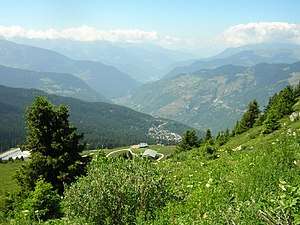Col de la Loze
Col de la Loze is a mountain pass in the French Alps, with an elevation of 2,304 metres (7,559 ft). A path up the mountain was opened in May 2019, and is the seventh-highest mountain pass in France. The ascent featured in the 2019 Tour de l'Avenir, and will also feature in the 2020 Tour de France.
| Col de la Loze | |
|---|---|
 View from the summit of Col de la Loze | |
| Highest point | |
| Elevation | 2,304 m (7,559 ft) |
| Coordinates | 45°24′18″N 6°36′07″E |
| Geography | |
| Parent range | French Alps |
Geography
Col de la Loze is in Les Trois Vallées, at an elevation of 2,304 metres (7,559 ft).[1][2] From Col de la Loze, one can ski to the nearby La Tania,[3][4] and Le Praz.[4] By chairlift, one can get from Col de la Loze to Courchevel and Méribel, and by button lift, one can get to La Tania.[5] From Col de la Loze, one can also cycle to Lac Bleu.[6]
A path up the Col de la Loze was built in 2018[2] and was officially opened on 12 May 2019.[2] On the official opening day, there was still snow on the mountain,[7] and it was the first French mountain pass to be cleared of snow.[2] Vehicles are not permitted on the path.[8] The path is paved on the side toward Courchevel, and unpaved on the side toward Méribel.[8] The path links Col de la Loze to Courchevel, and there are future plans to link the mountain path to Méribel, and continue the path to Val Thorens.[2] It is the seventh-highest mountain pass in France,[1] and the third-highest mountain pass in the Savoie region.[8]
Cycling
On 12 May 2019, the Col de la Loze held the Eiffage time trial event to commemorate its opening.[7][9] There were 2 races: one over a distance of 22.7 kilometres (14.1 mi), and one over a shorter distance of 8.6 kilometres (5.3 mi).[9]
The first professional cycle race to ascend to Col de la Loze was stage 8 of the 2019 Tour de l'Avenir.[10] The stage was won by Australia's Alexander Evans.[10] Col de la Loze is expected to be the summit finish for stage 17 of the 2020 Tour de France.[10] The stage includes an ascent of the Col de la Madeleine, which was not in the Tour de l'Avenir stage.[1][10] The climb up to Col de la Loze is 21.5 kilometres (13.4 mi) long, with an average gradient of 7.5%.[10] The route follows a route formerly used by a 7 kilometres (4.3 mi) mechanical ski lift.[11] The ascent starts in Brides-les-Bains and passes through Méribel, before turning onto the new path up to Col de la Loze.[12] The finish point is the highest point of the 2020 Tour.[12] Col de la Loze is one of two new summit finishes at the Tour, the other one being Grand Colombier.[1]
References
- Farrand, Stephen (15 October 2019). "Tour de France 2020 route revealed". Cyclingnews.com. Retrieved 26 March 2020.
- Gallotti, Annabelle (12 May 2019). "Une nouvelle route d'altitude dédiée aux cyclistes à Courchevel". France Bleu (in French). Retrieved 26 March 2020.
- Coxen, Adam; Hutchinson, Hugh; Goring, Jeremy (2005). Snow-Finder France. Wavefinder Limited. p. 183.
- Leocha, Charles (2007). Ski Snowboard Europe. World Leisure Corporation.
- "Les 3 Vallées Openings/Closings of Slopes and Lifts Live Timing". Les Trois Vallées. Retrieved 26 March 2020.
- Auzias, Dominique; Labourdette, Jean-Paul (2019). Alpes 2019/2020 Petit Futé (in French). Le Petit Futé.
- Aspden, Lucy (6 June 2019). "Ski resorts battle with walls of snow in rush to clear roads for summer". The Daily Telegraph. Retrieved 26 March 2020.
- "Col de la Loze : nouvel itinéraire cycliste". Le Dauphiné libéré (in French). 8 October 2018. Retrieved 26 March 2020.
- "Première course cycliste au "nouveau" col de la Loze". Le Dauphiné libéré (in French). 14 May 2019. Retrieved 26 March 2020.
- Hood, Andrew (17 October 2019). "New giant of the Alps could play kingmaker in 2020 Tour". VeloNews. Retrieved 26 March 2020.
- "Tour de France 2020 route includes 'crazy' new summit". The Connexion. 15 October 2019. Retrieved 26 March 2020.
- Henrys, Colin (18 October 2019). "8 key climbs from the 2020 Tour de France: Epic ascents to watch or ride". Bike Radar. Retrieved 26 March 2020.